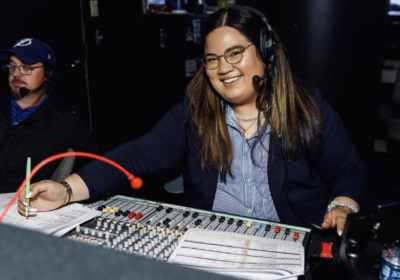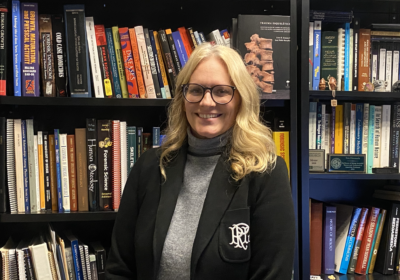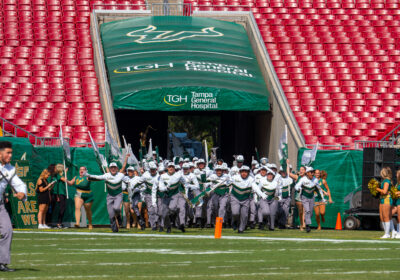Students battle in USF fight clubs

Fighting is an intricate part of human history. What was once an animalistic necessity for survival is now a well-groomed art form, used more commonly for exercise and competition than defending the clan.
At the USF Campus Recreation Center, students are picking up swords and brandishing their fists all in the name of learning these martial arts in a variety of combat-based clubs.
Judo Club
Judo may sound like a very heavy-handed fighting style but in reality, Danielle Rehberg, the current president of USF’s judo club, said it is just Japanese jiujitsu stripped of all the particularly dangerous moves. However, one of the main goals remains to physically throw your opponent.
“It’s definitely a combat sport,” Rehberg said. “Within about a month you’ll do your first throw, you’ll never injure anyone by doing that either. We’re actually just about as safe as golf.”
Rehberg has been practicing judo for a year and a half and has already been named state champion for the second time.
“It was actually a way for me to get back into athletic training,” Rehberg said. “I didn’t expect to like it at all and I just kind of fell in love with it after a couple weeks.”
During the fall and spring semesters the club has what Rehberg calls “a full mat” with roughly 30 to 40 members. She said about 95 percent of its new members have never even heard the word judo before.
“I was definitely one of them, I looked through all the sports clubs and went ‘seems interesting,’” Rehberg said. “It’s a very different sport from what anyone would usually do. You don’t normally wake up in the morning and say I wanna throw people, but it’s a huge stress relief.”
The judo club participates in competitions all across the state from Orlando to Miami. The club uses university funds to pay for competition entry so anyone can come along.
“Normally in fall we’ll have maybe two competitions, during the spring is really the competition season,” she said. “That works out great for anyone who joins in the fall because they can actually compete in the spring, you’ll have enough skills and knowledge to actually do that.”

Fencing Club
From swashbuckling rouges to gallant musketeers, the art of sword fighting has been heavily romanticized by popular culture.
“Another name for fencing is physical chess,” said Shannon Mangan, a sophomore studying musical performance and the president of USF’s fencing club. “A lot of it is physical but a lot of it is also really mental. You have to think steps ahead of your opponent.”
Apart from learning how to fight, Mangan said the club does a fair amount of conditioning. The club does a lot of leg exercises because the fighting stance is almost squatting. The average beginner sword is not particularly heavy, but after a few hours of practice Mangan said it can be difficult to keep your arm up.
“A lot of fencing is having a burst of stamina,” Mangan said. “A lot of it is lunge and retreat. It’s one jumping motion then you fling yourself backward so you don’t get hit in return.”
One of the aspects of fencing Mangan likes most is the people with whom she fences. She said the club attracts people from “all walks of school.”
“I found my best friends there,” Mangan said. “I didn’t think I’d find any best friends outside my major.”
Mangan said fencing is not for everyone and many people will show up for one practice then never come again.
“You can do a lot of research online, you can watch Olympic videos on YouTube … but actually showing up and meeting the people in that club — that’s when you’ll know,” she said.
Brazilian Jiujitsu Club
Alexander Tremper, a junior majoring in electrical engineering, said jiujitsu is like wrestling in that the goal is to gain control over your opponent. However, unlike wrestling, in a realistic setting you would incapacitate your opponent or even break one of his limbs.
“It’s an empowering thing both physically and mentally,” Tremper said.
Tremper has been practicing jiujitsu for about five years. He started fighting with boxing but decided that he needed to find some other way to fight that wouldn’t cause as much permanent injury. He joined the Brazilian jiujitsu club in the fall of 2013 and is now the club’s president.
“You’re learning how to use your opponent’s energy against them,” Tremper said. “It’s a back and forth kind of thing.”
During practices, students learn the proper way to fall, basic takedown maneuvers and core fighting techniques. Interested students need not have studied a martial art before joining the club. Tremper said anyone is welcome to attend practice and give it a try.
“You don’t have to be the most athletic person to come out and learn it,” he said.
Combat Club
The newest addition to the fight club family is the USF Combat Club. The club practices several styles of martial arts, pulling moves and styles from taekwondo, muay thai, wrestling and jiujitsu. Matthew Shirakawa, a junior majoring in marine biology, joined the club at its inception nearly a year ago.
“I started karate when I was four,” Shirakawa said. “You know when you’re that age, your parents want you to do something and I wanted out of baseball.”
Before starting with the Combat Club, Shirakawa had already earned a black belt in taekwondo.
“I kept doing it my whole life,” Shirakawa said. “I have fun doing it. I like to fight now. It’s like a hobby, it’s a passion and I’ll just keep doing it.”
Shirakawa said most of the club’s new members come in without any prior experience in any form of fighting.
“A buddy and I were doing the jiujitsu club, but their hours just didn’t work for us; we could only really get there late at night,” he said.
The club formed after people began to join Shirakawa and his friend during their late night practices. The combat club’s practices run from 10 p.m. to midnight.
“It’s great exercise and you might have fun,” Shirakawa said. “You won’t know unless you try.”







